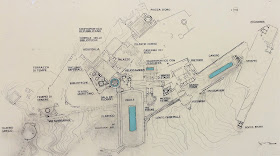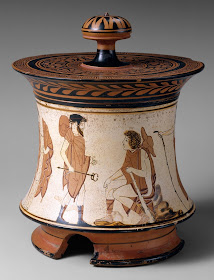The largest of all Roman villas was that built (and probably
designed) by the emperor Hadrian near Tibur (modern Tivoli). Its largest part
-- hard to miss when one looks at the model (above) or the plan (below) -- is
known as the Pecile.
The Italian name evokes a connection with the building erected in the Agora of Athens in the fifth century BC: the Stoa Poikile, famous both for the paintings it housed (hence its name, Painted Porch) as well as for its association with philosophy (Stoicism). A passage in the Historia Augusta (Hadrianus 26.5) records that Hadrian himself named this and other parts of his villa for famous places:
His villa at Tibur was marvellously constructed, and he actually gave to parts of it the names of provinces and places of the greatest renown, calling them, for instance, Lyceum, Academia, Prytaneum, Canopus, Poecile and Tempe. And in order not to omit anything, he even made a Hades.
The Pecile was a huge quadriporticus, i.e., a courtyard
enclosed by porticoes on all four sides, measuring 232 x 97 meters -- many
times larger than the celebrated Athenian building that supposedly inspired it.
The Pecile featured on its northern side
a double portico, of which the 9-meter-tall central spine wall is preserved, as
are the bases for the columns at regular intervals (intercolumniation = 3.6
meters) to either side.
The north side of the spine wall of the double colonnade, facing east: column bases are to the left.
The south side of the spine wall, facing west. The column bases are to the left. The pool is to the left of the trees.
The double colonnade had a gable roof. This photo shows the holes for the roof beams at the top of the spine wall.
Circular spaces at both ends of the spine wall allowed one
to do laps on this “track,” which was covered and thus offered protection in
inclement weather. This double colonnade may have been modeled on the running
track (dromos) that was part of a typical Greek gymnasion, which typically
offered two options: an open-air dromos called a paradromis and a roofed one
called a xystos.
The other three sides were covered, too, but they were single
porticoes; the east and west ones were slighty convex.
The quadiporticus surrounded a garden in the center
of which was a pool (piscina) measuring 100 x 25 meters.
The Pecile was the ideal place for exercise -- the daily
walk prescribed by doctors -- and for quiet contemplation, isolated as it was from
the rest of the villa by its walls except at the places where it communicated
with contiguous structures, such as the Sala dei Sette Filosofi and Ninfeo-Stadio
on the eastern side, or the Edificio con tre Esedre on the southern side. Did
it also have painted panels, like its namesake? Perhaps, though there is no
evidence that it did, apart from the name.
In fact, “Pecile” may be a misnomer, at least for the
entirety of what the term now designates, as Frank Sear has suggested. “The layout
of the whole area with the pool in the center and the large open space in the
middle suggests that the complex might well be an imitation of the Lyceum or
Academy in Athens rather then the Stoa Poikile.” It is true that the Athenian
Stoa Poikile was a much shorter structure, hardly a running track (cf. drawing by W. B. Dinsmoor above, top center).
The Pecile is built upon an artificial terrace that rises as
much as 15 meters on the western side, which was a separate part of the villa
known as the Cento Camerelle (Hundred Chambers, although there were in fact more
than a hundred -- the red lines in the photo show their disposition). These
were small cells in as many as four stories, apparently apartments for the service
staff, with wooden floors and accessed from wooden balconies except at the
ground level, which included storerooms and latrines. The cells were nearly
identical and had a single opening that served as both door and window. It is
estimated that they lodged some 1500 people.
- Bruciati, Andrea and Benedetta Adembri. Villa Adriana: Guida (2017) 62-65.
- Christesen, Paul and Donald G. Kyle. A Companion to Sport and Spectacle in Greek and Roman Antiquity (2014) 298-299.
- Sear, Frank. Roman Architecture (1983) 175-176.
















